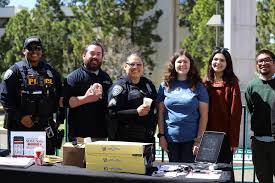The Importance of Community Policing
Community policing is a proactive approach to law enforcement that emphasizes building strong relationships between police officers and the communities they serve. This collaborative effort aims to create safer neighborhoods, reduce crime rates, and enhance trust between law enforcement agencies and residents.
One of the key principles of community policing is engagement. Police officers actively interact with community members, listen to their concerns, and work together to develop solutions to local issues. By fostering open communication and mutual respect, law enforcement agencies can gain valuable insights into the needs and priorities of the community.
Community policing also focuses on prevention rather than just response. Officers partner with residents, schools, businesses, and other organizations to implement crime prevention programs, educational initiatives, and neighborhood watch groups. By addressing underlying social problems and working proactively to deter criminal activity, community policing can help create a safer environment for everyone.
Moreover, community policing helps build trust and legitimacy in law enforcement. When residents see police officers as partners in promoting public safety rather than just enforcers of the law, they are more likely to cooperate with authorities, report crimes, and seek help when needed. This positive relationship can lead to increased public satisfaction with police services and a stronger sense of security within the community.
In conclusion, community policing plays a vital role in promoting collaboration between police departments and the communities they serve. By working together towards common goals, fostering trust through engagement, and focusing on prevention strategies, law enforcement agencies can create safer neighborhoods where residents feel empowered and supported. Community policing is not just a strategy—it is a philosophy that values partnership, communication, and shared responsibility in ensuring public safety for all.
Exploring Community Policing: Types, The Community Era, Crime Deterrence, and Core Objectives
- What are the 4 types of community policing?
- What is the community era of policing?
- What is community policing and does it deter crime?
- What is the core purpose of community policing?
What are the 4 types of community policing?
Community policing encompasses various strategies aimed at enhancing police-community relations and improving public safety. When discussing the types of community policing, four common approaches are often highlighted. The first type is “Strategic-Oriented Policing,” which involves setting clear goals and objectives for addressing community issues. The second type is “Problem-Oriented Policing,” where law enforcement agencies focus on analyzing and solving specific problems within communities. The third type is “Community-Oriented Policing,” emphasizing collaboration between police officers and residents to address local concerns collectively. Lastly, the fourth type is “Team-Oriented Policing,” which involves multi-disciplinary teams working together to address complex issues effectively. Each type plays a crucial role in promoting effective communication, trust-building, and proactive crime prevention efforts within communities.
What is the community era of policing?
The community era of policing, also known as community policing, represents a shift in law enforcement philosophy towards a more collaborative and proactive approach. During this era, police departments prioritize building strong relationships with the communities they serve, engaging in open dialogue, and working together to address local issues. Community policing emphasizes problem-solving, crime prevention, and community engagement over traditional reactive methods. By focusing on partnership and mutual trust between law enforcement and residents, the community era of policing aims to create safer neighborhoods, enhance public trust in the police, and promote a sense of shared responsibility for maintaining public safety.
What is community policing and does it deter crime?
Community policing is a proactive law enforcement strategy that emphasizes building strong relationships between police officers and the communities they serve. By engaging with residents, listening to their concerns, and working collaboratively to address local issues, community policing aims to create safer neighborhoods and enhance trust between law enforcement agencies and the public. While community policing may not eliminate crime entirely, its emphasis on prevention, community engagement, and partnership can help deter criminal activity by addressing root causes, promoting awareness, and fostering a sense of shared responsibility for public safety. Through these efforts, community policing seeks to create a supportive environment where residents feel empowered to work together with law enforcement to prevent crime and build a stronger, more resilient community.
What is the core purpose of community policing?
The core purpose of community policing is to establish strong partnerships and collaboration between law enforcement agencies and the communities they serve. By prioritizing proactive engagement, open communication, and mutual trust, community policing aims to create safer neighborhoods, reduce crime rates, and enhance the overall quality of life for residents. This approach shifts the focus from traditional reactive policing to a more preventative and community-centered model, where police officers work alongside community members to address local concerns, build relationships, and develop effective strategies for crime prevention and public safety. Ultimately, the core purpose of community policing is to foster a sense of shared responsibility and empowerment among both law enforcement personnel and residents in promoting a safer and more cohesive community.

